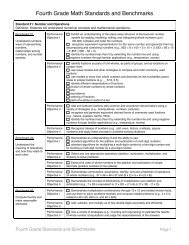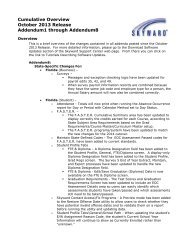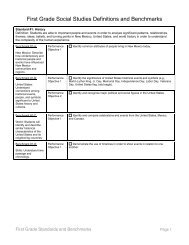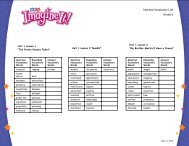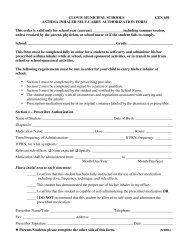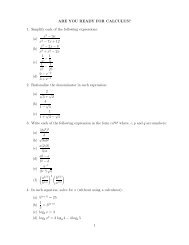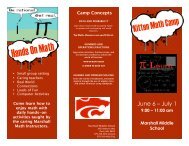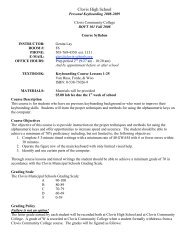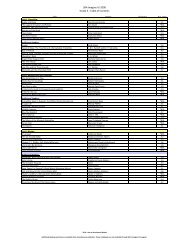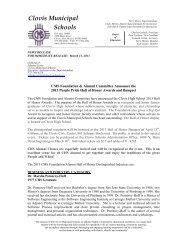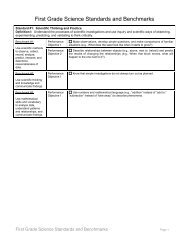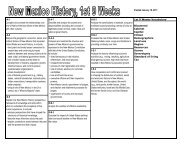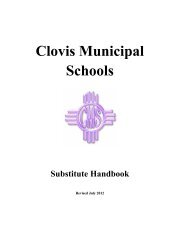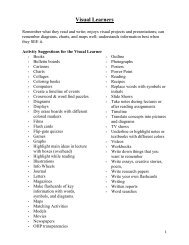Third Grade Science Standards and Benchmarks
Third Grade Science Standards and Benchmarks
Third Grade Science Standards and Benchmarks
You also want an ePaper? Increase the reach of your titles
YUMPU automatically turns print PDFs into web optimized ePapers that Google loves.
<strong>Third</strong> <strong>Grade</strong> <strong>Science</strong> <strong>St<strong>and</strong>ards</strong> <strong>and</strong> <strong>Benchmarks</strong><br />
St<strong>and</strong>ard #1: Scientific Thinking <strong>and</strong> Practice<br />
Definition I: Underst<strong>and</strong> the processes of scientific investigations <strong>and</strong> use inquiry <strong>and</strong> scientific ways of observing,<br />
experimenting, predicting, <strong>and</strong> validating to think critically.<br />
Benchmark #1:<br />
Use scientific methods<br />
to observe, collect,<br />
record, analyze,<br />
predict, interpret, <strong>and</strong><br />
determine<br />
reasonableness of<br />
data.<br />
Benchmark #2:<br />
Use scientific thinking<br />
<strong>and</strong> knowledge <strong>and</strong><br />
communicate findings.<br />
Benchmark #3:<br />
Use mathematical<br />
skills <strong>and</strong> vocabulary<br />
to analyze data,<br />
underst<strong>and</strong> patterns<br />
<strong>and</strong> relationships, <strong>and</strong><br />
communicate findings.<br />
Performance<br />
Objective 1<br />
Performance<br />
Objective 2<br />
Performance<br />
Objective 3<br />
Performance<br />
Objective 4<br />
Performance<br />
Objective 5<br />
Performance<br />
Objective 1<br />
Performance<br />
Objective 2<br />
Performance<br />
Objective 1<br />
Performance<br />
Objective 2<br />
Performance<br />
Objective 3<br />
Make new observations when discrepancies exist between two descriptions of the<br />
same object or phenomenon to improve accuracy.<br />
Recognize the difference between data <strong>and</strong> opinion.<br />
Use numerical data in describing <strong>and</strong> comparing objects, events, <strong>and</strong><br />
measurements.<br />
Collect data in an investigation <strong>and</strong> analyze those data.<br />
Know that the same scientific laws govern investigations in different times <strong>and</strong><br />
places (e.g., gravity, growing plants).<br />
Use a variety of methods to display data <strong>and</strong> present findings.<br />
Underst<strong>and</strong> that predictions are based on observations, measurements, <strong>and</strong> cause<strong>and</strong>-effect<br />
relationships.<br />
Use numerical data in describing <strong>and</strong> comparing objects, events, <strong>and</strong><br />
measurements.<br />
Pose a question of interest <strong>and</strong> present observation <strong>and</strong> measurements with<br />
accuracy.<br />
Use various methods to display data <strong>and</strong> present findings <strong>and</strong> communicate results<br />
in accurate mathematical language.<br />
<strong>Third</strong> <strong>Grade</strong> <strong>Science</strong> <strong>St<strong>and</strong>ards</strong> <strong>and</strong> <strong>Benchmarks</strong> Page 1
St<strong>and</strong>ard #2: Content of <strong>Science</strong><br />
Definition I (Physical <strong>Science</strong>): Underst<strong>and</strong> the structure <strong>and</strong> properties of matter, the characteristics of energy,<br />
<strong>and</strong> the interactions between matter <strong>and</strong> energy.<br />
Benchmark #1:<br />
Recognize that matter<br />
has different forms<br />
<strong>and</strong> properties.<br />
Benchmark #2:<br />
Know that energy is<br />
needed to get things<br />
done <strong>and</strong> that energy<br />
has different forms.<br />
Benchmark #3:<br />
Identify forces <strong>and</strong><br />
describe the motion of<br />
objects.<br />
Performance<br />
Objective 1<br />
Performance<br />
Objective 2<br />
Performance<br />
Objective 1<br />
Performance<br />
Objective 2<br />
Performance<br />
Objective 3<br />
Performance<br />
Objective 4<br />
Performance<br />
Objective 1<br />
Performance<br />
Objective 2<br />
Performance<br />
Objective 3<br />
Performance<br />
Objective 4<br />
Identify <strong>and</strong> compare properties of pure substances <strong>and</strong> mixtures (e.g., sugar, fruit<br />
juice).<br />
Separate mixtures based on properties ( e.g., by size or by substance; rocks <strong>and</strong><br />
s<strong>and</strong>, iron filings <strong>and</strong> s<strong>and</strong>, salt <strong>and</strong> s<strong>and</strong>).<br />
Underst<strong>and</strong> that light is a form of energy <strong>and</strong> can travel through a vacuum.<br />
Know that light travels in a straight line until it strikes an object <strong>and</strong> then it is<br />
reflected, refracted, or absorbed.<br />
Measure energy <strong>and</strong> energy changes (e.g., temperature changes).<br />
Construct charts or diagrams that relate variables associated with energy changes<br />
(e.g., melting of ice over time).<br />
Recognize that magnets can produce motion by attracting some materials (e.g.,<br />
steel) <strong>and</strong> have no effect on others (e.g., plastics).<br />
Describe how magnets have poles (N <strong>and</strong> S) <strong>and</strong> that like poles repel each other<br />
while unlike poles attract.<br />
Observe that some forces produce motion without objects touching (e.g., magnetic<br />
force on nails).<br />
Describe motion on different time scales (e.g., the slow motion of a plant toward<br />
light, the fast motion of a tuning fork).<br />
St<strong>and</strong>ard #2: Content of <strong>Science</strong><br />
Definition II (Life <strong>Science</strong>): Underst<strong>and</strong> the properties, structures, <strong>and</strong> processes of living things <strong>and</strong> the<br />
interdependence of living things <strong>and</strong> their environments.<br />
Benchmark #1:<br />
Know that living<br />
things have diverse<br />
forms, structures,<br />
functions, <strong>and</strong><br />
habitats.<br />
Benchmark #2:<br />
Know that living<br />
things have<br />
similarities <strong>and</strong><br />
differences <strong>and</strong> that<br />
living things change<br />
over time.<br />
Benchmark #3:<br />
Know the parts of the<br />
human body <strong>and</strong> their<br />
functions.<br />
Performance<br />
Objective 1<br />
Performance<br />
Objective 2<br />
Performance<br />
Objective 3<br />
Performance<br />
Objective 4<br />
Performance<br />
Objective 1<br />
Performance<br />
Objective 2<br />
Performance<br />
Objective 1<br />
Performance<br />
Objective 2<br />
Know that an adaptation in physical structure or behavior can improve an<br />
organism’s chance for survival (e.g., horned toads, chameleons, cacti, mushrooms.<br />
Observe that plants <strong>and</strong> animals have structures that serve different functions (e.g.,<br />
shape of animals’ teeth).<br />
Classify common animals according to their observable characteristics (e.g., body<br />
coverings, structure).<br />
Classify plants according to their characteristics (e.g., tree leaves, flowers, seeds).<br />
Identify how living things cause changes to the environments in which they live, <strong>and</strong><br />
that some of these changes are detrimental to the organism <strong>and</strong> some are beneficial.<br />
Know that some kinds of organisms that once lived on Earth have become extinct<br />
(e.g., dinosaurs) <strong>and</strong> that others resemble those that are alive today (e.g., alligators,<br />
sharks).<br />
Know that bacteria <strong>and</strong> viruses are germs that affect the human body.<br />
Describe the nutrients needed by the human body.<br />
<strong>Third</strong> <strong>Grade</strong> <strong>Science</strong> <strong>St<strong>and</strong>ards</strong> <strong>and</strong> <strong>Benchmarks</strong> Page 2
St<strong>and</strong>ard #2: Content of <strong>Science</strong><br />
Definition III (Earth <strong>and</strong> Space <strong>Science</strong>): Underst<strong>and</strong> the structure of Earth, the solar system, <strong>and</strong> the universe,<br />
the interconnections among them, <strong>and</strong> the processes <strong>and</strong> interactions of Earth’s systems.<br />
Benchmark #1:<br />
Know the structure of<br />
the solar system <strong>and</strong><br />
the objects in the<br />
universe.<br />
Benchmark #2:<br />
Know the structure<br />
<strong>and</strong> formation of Earth<br />
<strong>and</strong> its atmosphere<br />
<strong>and</strong> the processes<br />
that shape them.<br />
Performance<br />
Objective 1<br />
Performance<br />
Objective 2<br />
Performance<br />
Objective 3<br />
Performance<br />
Objective 4<br />
Performance<br />
Objective 5<br />
Performance<br />
Objective 1<br />
Performance<br />
Objective 2<br />
Performance<br />
Objective 3<br />
Performance<br />
Objective 4<br />
Describe the objects in the solar system (e.g., sun, Earth <strong>and</strong> other planets, moon)<br />
<strong>and</strong> their features (e.g., size, temperature).<br />
Describe the relationships among the objects in the solar system (e.g., relative<br />
distances, orbital motions).<br />
Observe that the pattern of stars stays the same as they appear to move across the<br />
sky nightly.<br />
Observe that different constellations can be seen in different seasons.<br />
Know that telescopes enhance the appearance of some distant objects in the sky<br />
(e.g., the moon, planet).<br />
Know that Earth’s features are constantly changed by a combination of slow <strong>and</strong><br />
rapid processes that include the action of volcanoes, earthquakes, mountain building,<br />
biological changes, erosion, <strong>and</strong> weathering.<br />
Know that fossils are evidence of earlier life <strong>and</strong> provide data about plants <strong>and</strong><br />
animals that lived long ago.<br />
Know that air takes up space, is colorless, tasteless, <strong>and</strong> odorless, <strong>and</strong> exerts a<br />
force.<br />
Identify how water exists in the air in different forms (e.g., in clouds <strong>and</strong> fog as tiny<br />
droplets; in rain, snow, <strong>and</strong> hail) <strong>and</strong> changes from one form to another through various<br />
processes (e.g., freezing/condensation, precipitation, <strong>and</strong> evaporation).<br />
St<strong>and</strong>ard #3: <strong>Science</strong> <strong>and</strong> Society<br />
Definition I: Underst<strong>and</strong> how scientific discoveries, inventions, practices, <strong>and</strong> knowledge influence, <strong>and</strong> are<br />
influenced by, individuals <strong>and</strong> societies.<br />
Benchmark #1:<br />
Describe how science<br />
influences decisions<br />
made by individuals<br />
<strong>and</strong> societies.<br />
Performance<br />
Objective 1<br />
Performance<br />
Objective 2<br />
Performance<br />
Objective 3<br />
Performance<br />
Objective 4<br />
Describe how food packaging (e.g., airtight containers, date) <strong>and</strong> preparation<br />
(heating, cooling, salting, <strong>and</strong> smoking, drying) extend food life <strong>and</strong> the safety of foods<br />
(e.g., elimination of bacteria).<br />
Know that science produces information for the manufacture <strong>and</strong> recycling of<br />
materials (e.g., materials that can be recycled [aluminum, paper, plastic] <strong>and</strong> others<br />
that cannot [gasoline]).<br />
Know that naturally occurring materials (e.g., wood, clay, cotton, animal skins) may<br />
be processed or combined with other materials to change their properties.<br />
Know that using poisons can reduce the damage to crops caused by rodents,<br />
weeds, <strong>and</strong> insects, but their use may ham other plants, animals, or the environment.<br />
<strong>Third</strong> <strong>Grade</strong> <strong>Science</strong> <strong>St<strong>and</strong>ards</strong> <strong>and</strong> <strong>Benchmarks</strong> Page 3



